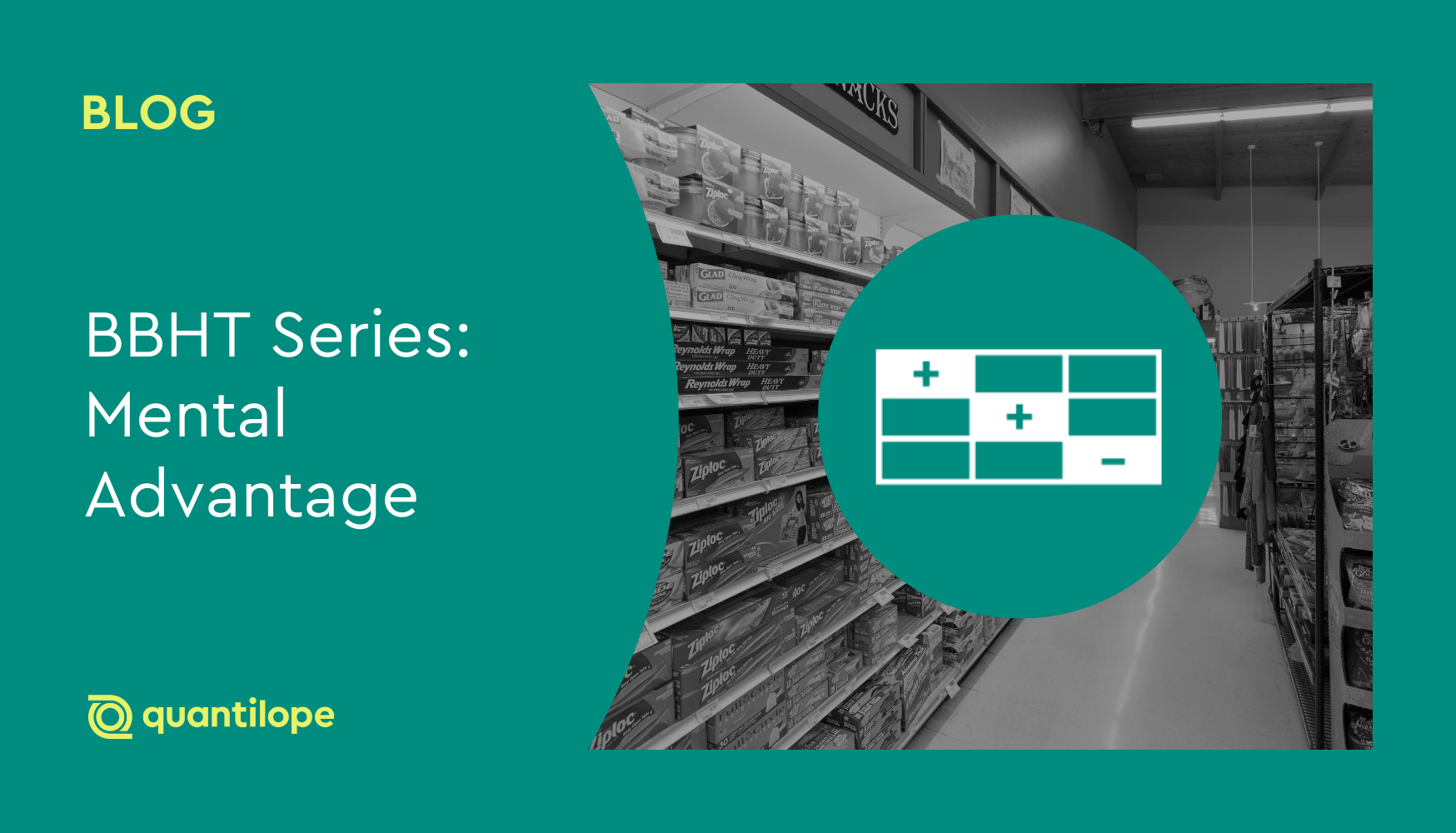Previously in our Better Brand Health Tracking series we've talked about everything from the basics of a BBHT approach to specific aspects of the solution such as Category Entry Points (CEPs) and Mental Availability. In this series post, we discuss another key type of BBHT analysis - Mental Advantage.
In her book, Better Brand Health, Research Professor Jenni Romaniuk (of the Ehrenberg-Bass Institute for Marketing Science) highlights how Mental Advantage accounts for two very important factors among category buyers: past brand buying/brand size and prototypical brand buying.
- Past brand buying/brand size:
When a consumer buys from a brand, they are far more likely to associate that brand with any given attribute than a consumer who has never purchased from that brand before. Because of that, the big-name, global companies within a category are going to get more attributions than smaller ones (potentially inflating the true results). - Prototypical brand buying:
Prototypical brand buying refers to the more obvious relationships an attribute or CEP has to its given category. Some attributes are more obviously related to a category, like 'anti-bacterial' for bandages or 'good battery life' for smartphones; these 'prototypical', or, common relationships will come out the strongest, making other attributes/CEPs appear less important for brands to consider (when in reality, they may be areas of great potential for the brand).
Brands need a way to account for the above factors in their strategy and ensure they have a true understanding of where to focus their attention and efforts. Enter: Mental Advantage Analysis.
A 'Mental Advantage' occurs when a brand scores higher than expected on a given attribute/CEP, given its brand size and how common those attributes/CEPs are to the category. To calculate where you have Mental Advantage for your brand, you first need to calculate the 'expected score' for all tested brand attributes. This is done by multiplying the following: (the sum of category buyers for one given attribute across all brands) by (the sum of category buyers for just your brand across all tested attributes) and dividing that by: (the total number of associations); this is your expected score. To find the attributes for which you have a so-called Mental Advantage, you'd subtract the expected score from your actual attribute score; if the difference is +5pp positive, you have Mental Advantage for that attribute/CEP! The opposite is also true; if the difference is -5pp or more, you have a Mental Disadvantage for that attribute/CEP.
Let's jump into some hypothetical data for say, a shoe brand. You're a shoe brand running a BBHT study that includes 4 other major shoe companies. Your brand attribute question includes elements like 'comfortable', 'lightweight', 'stylish', 'cross-functional', and 'easy to clean'. You're running your study among a total of n=1000 respondents, and the data for your brand attribute question turns out as follows (where each value represents the number of category buyers who associate a brand with that given attribute).
| Brand 1 (you) | Brand 2 | Brand 3 | Brand 4 | Brand 5 | Total | |
| Comfortable | 446 | 192 | 463 | 121 | 232 | 1454 |
| Lightweight | 452 | 364 | 478 | 303 | 341 | 1938 |
| Stylish | 396 | 562 | 407 | 328 | 235 | 1928 |
| Cross-functional | 459 | 470 | 474 | 286 | 274 | 1963 |
| Easy to clean | 445 | 343 | 446 | 325 | 305 | 1864 |
| Total | 2198 | 1931 | 2268 | 1363 | 1387 | 9147 |
Numbers bolded in table are simply to guide readers through below explanation.
To convert the above actual data into expected scores, let's use the value for 'comfortable' among Brand 1 (n=446). This is the number of consumers who associate your brand as 'comfortable' in your data set. Now, we're going to account for brand size and prototypical association.
Using the calculation explained above, we'll start by summarizing the number of category buyers across all brands for the attribute 'comfortable' (n=1454). We'll multiply that by the total for all associations for our brand only (n=2198) and divide that by the total number of associations (n=9147), to give us an expected score of 349 (see in table below).
Below is a calculation of all the expected scores for each brand and attribute:
| Brand 1 (you) | Brand 2 | Brand 3 | Brand 4 | Brand 5 | |
| Comfortable | 349 | 307 | 361 | 217 | 220 |
| Lightweight | 466 | 409 | 481 | 289 | 294 |
| Stylish | 463 | 407 | 478 | 287 | 292 |
| Cross-functional | 472 | 414 | 487 | 293 | 298 |
| Easy to clean | 448 | 394 | 462 | 278 | 283 |
Numbers bolded in table are simply to guide readers through below explanation.
To turn these into Mental Advantage values, we simply subtract the expected score from the actual score for each brand-attribute relationship, divide by total sample, and multiply by 100. For example, if we look at 'comfortable' for brand 1 (your shoe brand), we take (446-349= 97); divide by total sample (97/1000 = .097), and multiply by 100 (.097*100 = 9.7; which rounds up to 10).
| Brand 1 (you) | Brand 2 | Brand 3 | Brand 4 | Brand 5 | |
| Comfortable | 10 | -11 | 10 | -10 | 1 |
| Lightweight | -1 | -5 | 0 | 1 | 5 |
| Stylish | -7 | 15 | -7 | 4 | -6 |
| Cross-functional | -1 | 6 | -1 | -1 | -2 |
| Easy to clean | 0 | -5 | -2 | 5 | 2 |
As reflected above, any value +5 or higher is said to have 'Mental Advantage'. So, as Brand 1, we have Mental Advantage in the shoe category for 'comfortable' (as does brand 3). We could try to improve 'stylish' associations, but since Brand 2 has a very high Mental Advantage for that already (+15), we'd be better off competing with Brands 4 and 5 for attributes like 'easy to clean' or 'lightweight' - respectively. Meanwhile, because Brand 2 is the only brand to have Mental Advantage for 'stylish', (and the Mental Advantage value is so high at +15), it's time for that brand to start focusing on building new attribute links and widening its network size.
Overall, there are three different actions a brand can take depending on their Mental Advantage scores:
- Defend: your brand over-performs (+5 or higher) for a given attribute/CEP
- Build: your brand performs below expectations, with room to grow (-5 or lower)
- Maintain/Monitor: your brand is in line with expectations
Mental Advantage is an extremely valuable metric for brands to really understand where they currently win and where they might want to shift focus. Despite the complex calculations explained above, quantilope does all of this automatically and presents the final Mental Advantage values in an intuitive, color-coded table so even those who have no experience with the analysis can easily understand the key takeaways. Though it's commonly used for BBHT studies, Mental Advantage can be leveraged in any tracking study that uses a multi-matrix question type.
Ready to see where you (and your competitors) have Mental Advantages? Get in touch below!




.png)
